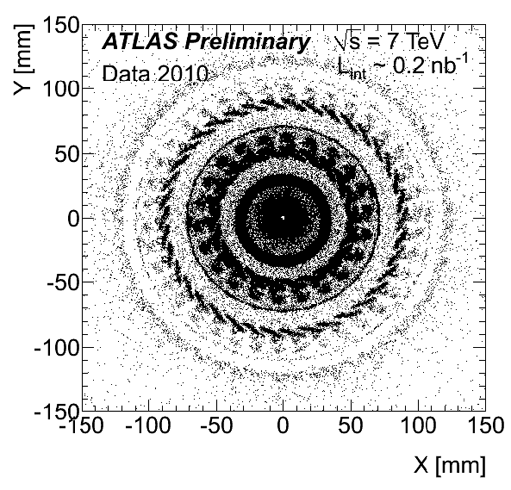
ATLAS e-News
23 February 2011
Detector detectives
13 July 2010

The Pixel detector, looking down the line of the beam. The thick band of the beam pipe, the 22 modules of the first Pixel layer, and the 38 modules of the second Pixel layer can be clearly seen. The third Pixel layer can just be discerned outside of these.
Hot on the heels of the material-mapping study reported in last week's e-News, a new study uses secondary hadronic interactions to map the material in the Pixel detector in great detail.
Building an accurate picture of the amount and distribution of ‚stuff’in the Inner Detector is crucial if ATLAS is to be able to reconstruct particle tracks with great precision. While the previously reported study focussed on photon conversions in material to assess where that material was, the new study looks at primary collision products – pions, protons, kaons and so on – as they undergo nuclear interactions with material in their paths.
“I mentioned something about starting this project in one of the Inner Detector Tracking Performance meetings,” remembers co-author Vivek Jain, “and Vadim [Kostyukhin] said that he had developed a software package that would be useful. We started collaborating on it.”
Vadim's software package looks for all vertices in an event. By applying cuts, tracks originating from the primary vertex – where protons collided in the centre of ATLAS – can be removed, leaving only those tracks resulting from secondary conversions.
“So you have these guys going out and they hit the material there and cause an interaction,” Vivek explains. “Depending on how much material there is, you'll have less or more interactions. It's like X-ray [imaging] – the more material you have, the denser [the image] looks.“
The two methods – the first based on electromagnetic conversions, and this one based on hadronic interactions – are complementary, according to Vivek. “But one of the major advantages of our method is that it has very good precision.” Precision that reveals fine details like the position of each tiny screw, in fact.
“In the third Pixel layer, we can locate the vertex with a precision of about 1 millimetre,” says Vadim. “But at the beam pipe, or in the first Pixel layer, we can locate it with a precision of about 200 microns.”
This is because the innermost vertices are estimated using three layers of fine resolution Pixel hits whereas the outer vertices are inherently less precise, as they must be estimated using hits outside the Pixel, in the lower resolution SCT and TRT.
Incorporating less than 1 per cent of the total cumulative dataset – about 0.2 nb-1 at 7 TeV centre of mass energy – Vivek and Vadim's work is really a feasibility study to show the potential of what could be done with this method. Already though, they have revealed discrepancies between the real-life detector geometry and that which is accounted for in the simulation.
The images at the end of this article show overlaid information describing each of the 22 modules of the first Pixel layer, for real data and Monte Carlo respectively. The more diffuse nature of the real data image indicates that each module is in a slightly different position than predicted. The beam pipe, too, is off-centre by around two millimetres. Although a shift of this magnitude was completely expected, the details of its exact size and direction weren't known until now.
The next step will be for this improved knowledge of the detector to be fed back into the simulation software to improve tracking accuracy. “The question is how exactly to do this, but all these things do need to be put back,” says Vivek.
As well as improving knowledge of the material in the detector, the hadronic material mapping technique will also be critical in some new physics searches. For instance, some Supersymmetric models propose particles that decay at large distances from the primary vertex, meaning that accurate knowledge of the material in the Inner Detector will be essential for distinguishing between real decays and the simple material interactions which could mimic these and skew results.

The current discrepancy between data (left) and Monte Carlo (right), seen by comparing overlaid images of the 22 modules of the first Pixel layer.
 Ceri PerkinsATLAS e-News
|